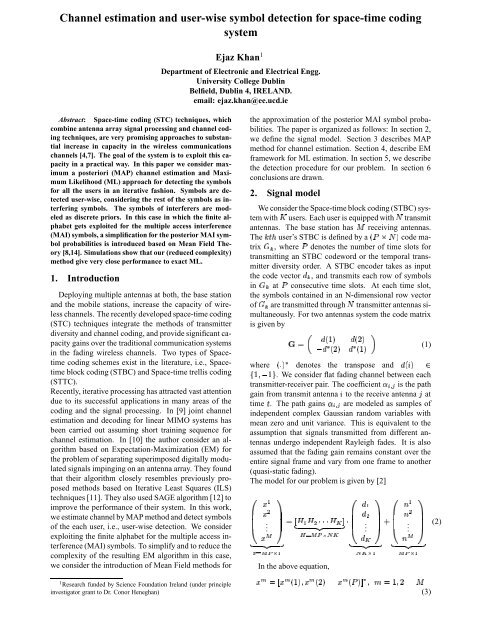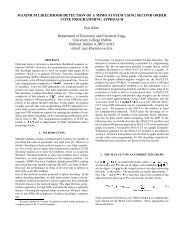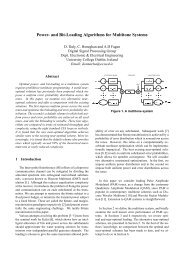Channel estimation and user-wise symbol detection for space-time ...
Channel estimation and user-wise symbol detection for space-time ...
Channel estimation and user-wise symbol detection for space-time ...
Create successful ePaper yourself
Turn your PDF publications into a flip-book with our unique Google optimized e-Paper software.
E[¥[Rf(RRR¥>>@>AE[f 2fj55 >(XR2 ff/55 >E@(^¨§R9¨R¨§9'9Rconsist of the received signal from <strong>time</strong> slots to © ,at jk¤§¦ the receiver antenna.response of the £ <strong>user</strong> <strong>and</strong>gQ¥]¨§'¥"¨$% denotes the channel ¥"¨¡ SUSDSis the code vector of £¥¤§¦ the <strong>user</strong>, ""¨,-d. withX [<strong>and</strong>_ fQf ¨'h _ f ¨% _SDSDS _ f ¨©i! (4)(5)0 %1 ;is the additive noise vector at j)¤§¦ the receiver! denotes transpose operator.antenna.¨'*+For single <strong>user</strong>, the Alamouti scheme, (two transmit antennas),STBC is given bywhere © ¨is prior on . We assume that prioron is zero mean Gaussian (which can be correlatedor uncorrelated). We will use MAP method <strong>for</strong>Rchannel <strong>estimation</strong> <strong>for</strong> correlated <strong>and</strong> <strong>for</strong> Runcorrelatedcase. MAP method is superior than maximum likelihood(ML) because we take into account the prioriknowledge about the channel matrix. The probability ofchannel matrix when there are correlations both transmitting<strong>and</strong> at the receiver end is given © ¨R¨cR [by, . Where i0 ¥ ¨are correlation< ¨matrices <strong>and</strong> is a constant. Taking logarithm of Eq.10,plugging the corresponding expressions <strong>and</strong> differentiatingwith respect to givesR < f ¨§ f ¨$%( < ¨' ¨$%! ¨ ! ¨'h)( Y§*) > * (12) 2¦ §#"§$§#""&%'("(% _ f ¨§ ^f ¨$% ( _(6)Where % represents Kronecker product <strong>and</strong> vec(.) isvectorization operator. In case of uncorrelated antennaswe haveR ¦ § "¨ ! Z¨ ¨§¨ @ ¨It can be further written as ) > (13)f ¨§
R>>^>XX R>R>>> >R>>@1[>R>R>RR> >>[>R>R>>auxiliary¤£¦¥aQ 9 9 § §0¢¡ ,function , which¨-,e0¢¡ , + ¨-,/.is the expected value of the complete data likelihood,given the observed ¡ , data D <strong>and</strong> the parameter computedat the previous iteration. Intuitively, computing correspondsto filling the missing data using the knowledgeof the observed data <strong>and</strong> previous parameters. The auxiliaryfunction is deterministic <strong>and</strong> can be maximized.An EM algorithm iterates the following two steps, <strong>for</strong>k=1,2,...., until a local or global maximum of the likelihoodis found.Expectation: Computeof the rest of the <strong>user</strong>s. Without loss of the generality, wedetect the <strong>symbol</strong>s <strong>for</strong> <strong>user</strong> 1 first, <strong>and</strong> <strong>for</strong> <strong>user</strong> in thelast, i.e., in the ascending order of the <strong>user</strong>s. Given theabove model we are now ready to define complete dataset. We choose complete data set /< 0 1 as . Thederivation of the algorithm is as follows: The pdf of thecomplete data set can be written as,where ¨
R55R@3¨>>) >§>©\@¨^R^R^>¨R0>¤RR6X Q356>>6¨3£3§The MF approximation is obtained by taking the approximatingfamily of probability distribution by all productdistribution, i.e.,<strong>and</strong> similarly variational energy can be written as© 3+6 j 3 j 6 j 3 , 3 (36)¨ ¡We now choose a distribution which is close to thetrue distribution, i.e., ¨ < . 0 . The parameter ofthe distribution is chosen so as to minimize Kullback-Leibler (KL) distance, i.e.,6 6 ¨ 6 Z* (24)In order to evaluate j 3 we have to minimize the variationalfree energy, i.e.,Q X Q XQ X(37) *Differentiating this equation with respect j3 to givesnonlinear fixed point equations, i.e.,^£¢ ¨ R . < ¨where ¨ ¦§£¨ ¨ 0¥¤0l¨ < .(25)/%0D%1 .¨ h'¡SUSDS(38)In the matrix <strong>for</strong>m we can write the above equation asZ0 (39)j 3©3 6Uj 63 I0§,0l_ ¦`¨§0l "!^¨ R.
0.05channel <strong>estimation</strong> error10 0 SNR in dB0.0450.040.03510 −1MSE0.030.025Av. BER0.0210 −20.0150.010.00510 −30 1 2 3 4 5 6 7 0 1 2 3 4 5 6 7 8SNR in dBFigure 1: <strong>Channel</strong> estimate error vs ¡¡ N¨6. Conclusions <strong>and</strong> simulationsIn this work, we proposed channel <strong>estimation</strong> <strong>and</strong><strong>symbol</strong> <strong>detection</strong> <strong>for</strong> the Space-<strong>time</strong> block coded multi<strong>user</strong>system. The channel is estimated by MAP procedureusing short training sequence. After estimatingthe channel the <strong>symbol</strong> <strong>detection</strong> is per<strong>for</strong>med <strong>user</strong>-<strong>wise</strong>considering other <strong>user</strong>s as interferers. Discrete prioris assumed on the interfering <strong>user</strong>s’ bits. In this case,the complexity of computing the posteriori probabilitiesgrows exponentially in the number of interfering <strong>user</strong>s<strong>time</strong>s the <strong>symbol</strong>s per <strong>user</strong>. We derived low complexitymethod to circumvent this problem. The exact posterioriprobabilities are replaced by the approximate separabledistributions. The distributions are calculated by MFT(variational approach). For simulations we consider ascenario in which there are two <strong>user</strong>s. We consider thecase of two transmit <strong>and</strong> four receive antennas. Figure 1shows the channel <strong>estimation</strong> error <strong>for</strong> the system. Figure2 shows the BER versus SNR <strong>for</strong> two <strong>user</strong>s withperfect channel state in<strong>for</strong>mation at receiver. It is clearfrom the figure that the behavior of our algorithm is veryclose to the exact ML curve. It is also clear from figure2 that we obtain better BER with the linear response theoryin comparison to the naive mean field theory. Figure3 shows the BER versus SNR <strong>for</strong> the same system parametersas in figure 2 but with estimated channel. Thisfigure shows that the per<strong>for</strong>mance degrades when thereis channel <strong>estimation</strong> error. It is also clear from this figurethat linear response theory outper<strong>for</strong>ms naive meanfield theory.REFERENCES[1] M. Opper <strong>and</strong> D. Saad, eds,”Advanced mean fieldmethods: Theory <strong>and</strong> practice”. MIT press, 2001.[2] B. Lu <strong>and</strong> X. Wang, “Iterative receivers <strong>for</strong> multi<strong>user</strong>Space-<strong>time</strong> coding systems,” IEEE JSAC vol.18, No. 11, November 2000.[3] A. B. Dempster, N. B. Liard, <strong>and</strong> D. B. Rubin, “Maximum likelihood from incomplete data via EM .Figure 2: Av. BER of K=2, N=2, M=4 vs ¡¢ W¨ .The solid line represents ML by enumeration when channelis exactly known. Square-solid line is ML using linearresponse theory using exact channel <strong>and</strong> star-solidline is ML using naive mean field theory using exactchannel.algorithm”, Journal of Royal Statistical society B,vol.39, no.1, pp. 1-38, 1977.[4] V. Tarokh, H. Jafarkhani, <strong>and</strong> A. R. Calderbank,“Space-<strong>time</strong> block coding <strong>for</strong> wireless communications:per<strong>for</strong>mance results,” IEEE JSAC vol. 17, No.3, March 1999.[5] E.de. Carvalho <strong>and</strong> D.T.M. Slock, “Maximum likelihoodFIR multi-channel <strong>estimation</strong> with Gaussianprior <strong>for</strong> the <strong>symbol</strong>s,” Proc. ICASSP, Munich, Germany,April 1997.[6] G. McLachlan <strong>and</strong> T. Krishnan, “The EM algorithm<strong>and</strong> extensions”, John Wiley ad sons Inc. 1997.[7] V. Tarokh, A. Naguib, N. Seshadri, <strong>and</strong> A. R. calberbank,“Combined array processing <strong>and</strong> <strong>space</strong>-<strong>time</strong>coding”, IEEE Tran. In<strong>for</strong>mation Theory, vol. 45,No. 4, May 1999.[8] G. Parisi, ”Statistical field theory”, Addison Wesley,Redwood, CA, 1988.[9] A. Grant, ”Joint decoding <strong>and</strong> channel <strong>estimation</strong> <strong>for</strong>linear MIMO channels”, Wireless comms. <strong>and</strong> networkingconf. , Chicago, Sep. 2000.[10] P. Bohlin, ”Iterative least square techniques withapplication to adaptive antennas <strong>and</strong> CDMAsystems”,Licentiate thesis, Chalmers Univ. of Tech.,Goteborg, Sweden, 2001. .[11] S. Talwar, M. Viberg, <strong>and</strong> A. Paulraj, ”Blind separationof synchronous Co-channel digital signals usingan antenna array - Part I: Algorithms”, IEEETrans. on Signal Processing, vol. 44(5), pp. 1184-1197, May, 1996.
10 010 −1Av. BER10 −210 −30 1 2 3 4 5 6 7 8SNR in dBFigure 3: Av. BER of K=2, N=2, M=4 vs ¡¢ W¨ .The solid line represents ML by enumeration when channelis exactly known. Dashed line is ML using linearresponse theory using estimated channel <strong>and</strong> star-solidline is ML using naive mean field theory using estimatedchannel.[12] J. A. Fessler, <strong>and</strong> A. O. Hero, ”Space-AlternatingGeneralized Expectation Maximization Algorithm”, IEEE Trans. on Signal Processing, vol.42(10). pp.2664-2677, Oct. 1994.[13] P. F. R. Sorensen, O. Winther, <strong>and</strong> L. K. Hansen,”Mean field approaches to independent componentanalysis”, Neural Computation, pp.889-918, 2002.[14] M. Opper, <strong>and</strong> O. Winther, ”Variational linear response”, In advances in Neural In<strong>for</strong>mation Processing(NIPS), 2003.




